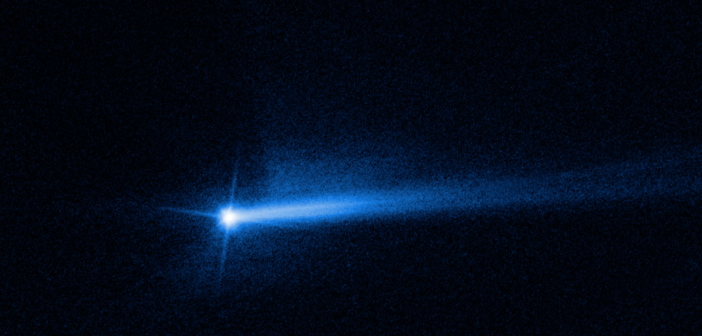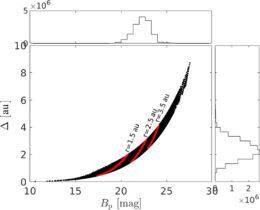A bold NASA experiment demonstrated that when an asteroid runs into something really hard, all of the ejected material reflects extra light back to Earth and makes the bruised asteroid appear slightly brighter for a short time. Recently, astronomers have built on that finding to estimate the chances of observing a similar flash out in the wilds of the main belt when two asteroids bump into each other by chance.
A DART of Inspiration
Back in September of 2022, NASA did its best to avenge the dinosaurs by slamming a small spacecraft into the moon of an asteroid. Aside from their vindictive motives, the agency had another, slightly more important reason for such an aggressive act. Astronomers and planetary defense experts wanted to watch how the asteroid would respond to a high-speed collision, and knowing exactly when one would occur allowed them to be ready with their telescopes. The Double Asteroid Redirection Test (DART) mission, as it was called, was a fabulous success, and the scientists involved got plenty of data along with the satisfaction of carrying out revenge 65 million years in the making.

A close-up view of the aftermath of the DART impact captured by a nearby spacecraft. [ASI/NASA/APL]
Now, many months after the initial excitement, a team of astronomers led by Eran Ofek, Weizmann Institute of Science, have hit upon a realization: if asteroids flash during a collision, could we detect the small blips caused by an impact between two natural asteroids, instead of an asteroid and a human-made spacecraft?
Estimating Collision Rates
To answer their question, Ofek and collaborators needed to combine the answers to two smaller questions. First, would these natural collisions be bright enough to observe from Earth? Second, how often would these collisions actually take place? Both questions are non-trivial to solve, though following the success of DART, the first was slightly easier to tackle.
By scaling the actual light curve collected after the DART mission came to its abrupt conclusion, the team could establish what the artificial impact would have looked like had the spacecraft and its target been teleported to the main belt of asteroids. The second question about the frequency of these collisions was more challenging to answer. Unfortunately, astronomers have nearly no idea how common asteroids the size of DART are in the solar system, since asteroids that small don’t reflect enough light to be observable from Earth. Luckily, the larger asteroids that they can observe seem to follow a power-law distribution in size, so by extrapolating that empirical relation to smaller objects, they can get a sense of how many unseen asteroids swarm in the dark.Potential for Discoveries
Combining their insights, the researchers established that about 7,000 asteroid collisions could be detectable every year, plus or minus about an order of magnitude. That’s thrilling, but also puzzling: if multiple asteroids slam into each other and flash every night, why haven’t we seen them? The team offered two solutions: first, we actually have detected this phenomenon, and collisions make up at least a subset of the three or so “active asteroids” that are spotted each year. Second, these flashes are just too short to be caught by standard surveys, which would have to observe the same spot in the sky at least twice in one hour to resolve the brightening. Happily, that means with the right survey design, we could potentially recover many more of these collisions. Perhaps in the years to come astronomers will observe asteroid collisions even when they aren’t the cause of them.
Citation
“Asteroid Collisions: Expected Visibility and Rate,” Eran O. Ofek et al 2024 AJ 167 190. doi:10.3847/1538-3881/ad2c03


